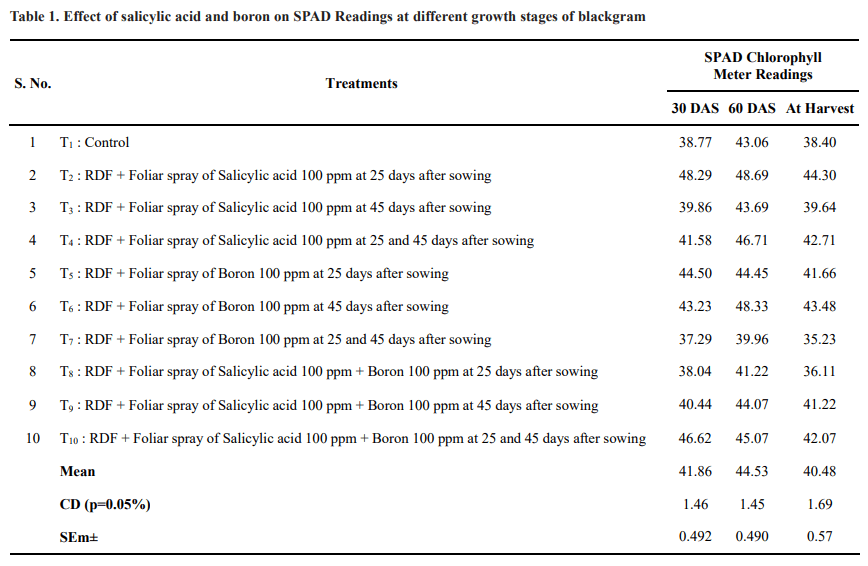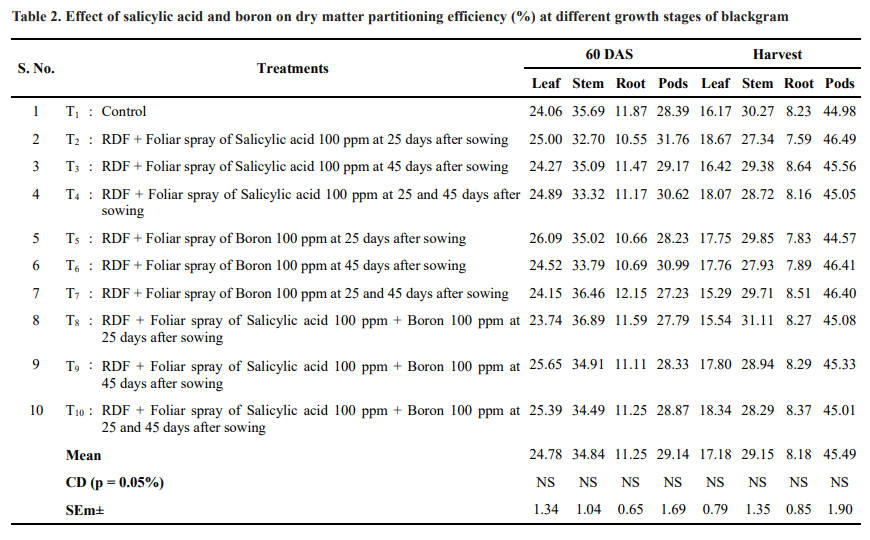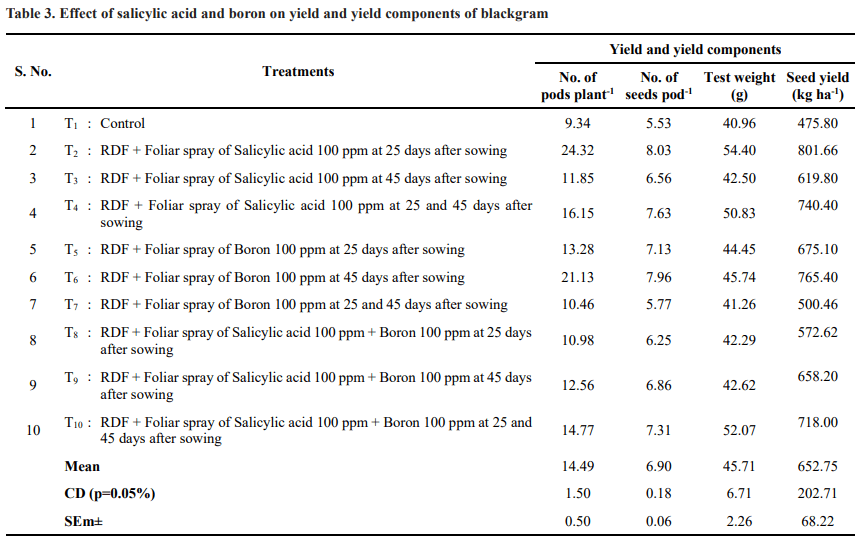Enhancement of Source-Sink Relationship in Blackgram (Vigna Mungo (L.) Hepper) Through Foliar Application Of Salicylic Acid and Boron
0 Views
K. VISHNU PRIYA*, A.R. NIRMAL KUMAR, V. UMAMAHESH AND K.V. HARIPRASAD
Department of Crop Physiology, S.V. Agricultural College, ANGRAU, Tirupati.
ABSTRACT
A field experiment was conducted during rabi, 2019 at dry land farm of S.V. Agricultural College, Tirupati to study the effects of foliar application of salicylic acid and boron in enhancing the source-sink relationship in blackgram (Vigna mungo (L.) Hepper) with ten treatments. Among the various treatments imposed T2 (Recommended dose of fertilizer (RDF) + foliar spray of salicylic acid @ 100 ppm at 25 (DAS) days after sowing) recorded highest dry matter partitioning efficiency of 31.76 per cent and 46.49 per cent in pods at 60 DAS and harvest respectively. Similarly, treatment T2 recorded highest SPAD chlorophyll meter readings at 30 DAS (48.2) and 60 DAS (48.69), number of pods plant-1 (24.32), number of seeds pods-1 (8.03), test weight (54.40 g) and seed yield (801.66 kg ha-1). Whereas, T (RDF + foliar spray of boron 100 ppm at 25 and 45 DAS) recorded lowest values for dry matter partitionin (27.23%) at 60 DAS, SPAD (37.29), number of pods plant-1 (10.46), test weight (41.26 g) and seed yield (500 kg ha-1).
KEYWORDS:
Boron, Blackgram, Salicylic acid, SPAD
INTRODUCTION
Pulses are commonly known as food legumes, belongs to family Fabaceae and have an unique ability of biological nitrogen fixation, mobilization of insoluble soil nutrients with their deep root system hence, popularly known as wonderful gift of nature. Pulses are rich source of proteins compared to cereals hence they possess great importance in Indian Agriculture (Prajapati et al., 2017). World health organization recommends per capita consumption of pulses as 80 g day-1.
Blackgram occupies fourth position in terms of area, production and productivity in India, it is cultivated in an area of about 4.48 m ha with production of 2.8 mt and productivity of 632 kg ha-1. In Andhra Pradesh it is cultivated in an area of 5 m ha with production of 3.29 m t and productivity of 658 kg ha-1 (Anonymous, 2017). Blackgram is one of the utmost important pulse crop with high price and cultivated in almost all parts of India. It has perfect combination of all nutrients, which includes carbohydrates (60%), proteins (26%), fat (1.5%),calcium (154 mg), minerals (3.2%), phosphorous (385 mg), fiber (0.9%), 9.1 mg of iron and vitamin B-complex (Jadhav et al., 2019).
Potential of blackgram in terms of yield is poor as it is mainly grown in rainfed condition with meager management practices and also due to several physiological and biochemical processes hampering the crop growth. Physiological problem like flower drop and premature shedding of reproductive structure diminishes number of potential sinks which seems to be associated with nutrient deficiency and hormonal imbalance and results in reduced translocation of dry matter to reproductive parts. Further, the reduction of blackgram yield is due to inadequate partitioning of assimilates, poor pod formation and lack of nutrients availability during critical stages of crop growth which may be improved through foliar application of growth hormones coupled with micronutrients play a major role in improving the source sink relationship through increased capacity of source and increased translocation of assimilates to sink. (Kumar et al., 2018).
Salicylic acid plays an important role in controlling plant growth and development and also plays a main role in response to environmental stresses. Boron is an essential element which is vital for plant growth and development. It is especially required in meristematic cells and essential for actively growing areas of plants such as newly forming leaves, root tips and bud development (Ahmad et al., 2009).
However, collective result of salicylic acid and boron on physiological behaviour of plant growth, metabolism and development is scanty and is of a research priority. Therefore, the present study was formulated to study the influence of salicylic acid and boron on source-sink relationship of blackgram.
MATERIAL AND METHODS
The experiment trial was carried out during rabi, 2019, at S.V. Agricultural College farm, Tirupati. The experiment was laid out in randomized block design with 10 treatments replicated thrice. The treatmental details composed of T1 : Control(RDF- 20 kg N and 50 kg P2O5 as basal), T2 : RDF + Foliar spray of Salicylic acid 100 ppm at 25 days after sowing,T3 : RDF + Foliar spray of Salicylic acid 100 ppm at 45 days after sowing,T4 : RDF + Foliar spray of Salicylic acid 100 ppm at 25 and 45 days after sowing, T5 : RDF +Foliar spray of boron100 ppm at 25 days after sowing, T6 : RDF + Foliar spray of Boron 100 ppm at 45 days after sowing, T7 : RDF + Foliar spray of Boron 100 ppm at 25 and 45 days after sowing, T8 : RDF + Foliar spray of Salicylic acid 100 ppm + Boron 100 ppm at 25 days after sowing, T9 : RDF + Foliar spray of Salicylic acid 100 ppm + Boron 100 ppm at 45 days after sowing,T10 : RDF + Foliar spray of Salicylic acid 100 ppm + Boron 100 ppm at 25 and 45 days after sowing. The concentrations used in the experiment were salicylic acid @ 100 ppm and boron @ 100 ppm. The seed variety used in the experiment was TBG-104.
The concentrations used in the experiment were salicylic acid @ 100 ppm and boron @ 100 ppm. Three irrigations were given to the crop i.e., at the time of sowing, 20 DAS and at flowering stage.
SPAD chlorophyll meter reading (SCMR)
SPAD chlorophyll meter readings (SCMR) were taken by following the method of Turner and Jund (1991) and the data was recorded on 5th or 6th leaf from top of each representative plant, between 8.00 a.m. and 9.00 a.m. at 30, 60 DAS and harvest.
Dry matter partitioning efficiency
Total dry matter partitioning efficiency was estimated in five plants by randomly pulled out with root system intact from each treatment in three replications and separated into roots, stems, leaves and pods. The plant parts were dried to a constant weight in hot air oven at 80ºC for 48 hours and the dry weights were recorded and expressed in g plant-1.
Yield and yield components
Number of pods plant-1, number of seeds per pod was counted for the five tagged plants and the mean value was calculated.
For test weight thousand seeds were drawn at random from each treatment in three replications and then weighed. It is expressed as the average value of test weight. Seed yield was calculated as seed from each plot was weighed and expressed as gram plant-1. Seed yield also calculated for a net plot area and it was computed to hectare and expressed as kg ha-1.
The experimental data were analyzed statistically by following standard procedure outlined by Panse and Sukhatme (1985). Significance was tested by comparing ‘F’ value at 5 per cent level of probability. Further the data was analyzed by OPSTAT (Operational statistics) software.
RESULTS AND DISCUSSION
Parameters such as SPAD chlorophyll meter reading, dry matter partitioning efficiency (%) and yield attributes viz., number of pods plant-1, number of seeds pod-1, test weight and seed yield kg ha-1 were significantly influenced by treatments are presented in the Tables.
Among the treatments at 60 DAS significantly high SCMR (48.69) was recorded in T2 (RDF + Foliar spray of Salicylic acid 100 ppm at 25 days after sowing) which was on par with T6 (48.33) followed by T4 (46.71). Whereas T7 (39.96) recorded significantly low SCMR which was on par with T8 (41.22) followed by T1 (43.06) (Table 1). Similar trend was observed at harvest. Our results were supported by Bhattacharya et al. (2004) who reported a similar increase in chlorophyll content in blackgram with the application of boron.
Among the treatments at 60 DAS T5 (26.09 %) recorded highest partitioning in leaf, T8 (36.89%) in stem, T7 (12.15%) in root and T2 (31.76 %) translocated more amount of assimilates to pods. Whereas at harvest, maximum dry matter partitioning were obtained in T2 (18.67%), T8 (31.11%), T3 (8.64%) and T2 (46.49%) in leaf, stem, roots and pods respectively. Decreasing leaf and stem dry weight might be due to remobilization of assimilates towards grain at maturity. At harvest maximum dry matter partitioning was obtained in T2 (18.67%), T8 (31.11%), T3 (8.64%) and T2 (46.49%) in leaf, stem, roots and pods respectively (Table. 2). Similar trend was observed by Kulsum et al. (2007) in blackgram. In dry matter partitioning, most of the treatments conferred more than 40% assimilates to the pods at maturity. Due to foliar application of nutrients and hormones leaf area and assimilation of photosynthates in leaf increased and ultimately higher assimilates partitioned to pod than control.



dry matter partitioning was obtained in T2 (18.67%), T8 (31.11%), T3 (8.64%) and T2 (46.49%) in leaf, stem, roots and pods respectively (Table. 2). Similar trend was observed by Kulsum et al. (2007) in blackgram. In dry matter partitioning, most of the treatments conferred more than 40% assimilates to the pods at maturity. Due to foliar application of nutrients and hormones leaf area and assimilation of photosynthates in leaf increased and ultimately higher assimilates partitioned to pod than control.
Yield components viz., number of pods plant-1, number of seeds pod-1, test weight and seed yield kg ha-1 were recorded highest with T2 : RDF + Foliar spray of Salicylic acid 100 ppm at 25 days after sowing (Table 3). Our results are supported by Ram et al. (2017) and Rawat et al. (2019) where number of pods plant-1 recorded highest with the application of boron and salicylic acid. Kaisher et al. (2010) reported that application of sulphur and boron increased number of seeds pod-1 in mungbean.
It is due to fact that boron plays a role in cell division, sugar and starch formation, carbohydrate metabolism, which further increases the size and weight of grain (Kaisher et al., 2010). Ali and Mahmoud (2013) confirmed that application of salicylic acid recorded the highest 1000 seed weight in blackgram.
Higher seed yield in black gram (Darade et al., 2019) is due to better partitioning of assimilates from sources to sink. Manjri et al. (2018) found that highest seed yield in blackgram obtained with foliar spray of salicylic acid.
CONCLUSION
With the application of nutrients and growth regulators enhanced pods to flower ratio being increased availability of nutrients and subsequently better translocation of assimilates from source to sink by preventing flower abortion and increased pod setting, number of pods plant-1, seeds pod-1, test weight and seed yield kg ha-1.
LITERATURE CITED
Ahmad, W., Niaz, A., Kanwal, S., Rahmatullah and Rasheed, M.K. 2009. Role of boron in plant growth: A Review. Journal of Agricultural Research. 47(3): 329-338.
Ali, E.A and Mahmoud, A.M. 2013. Effect of foliar spray by different salicylic acid and zinc concentrations on seed yield and yield components of mungbean in sandy soil. Asian Journal of Crop Science. 5(1): 33-40.
Bhattacharya, S.S., Mandal, D., Chattopadhyay, G.N and Majumdar, K. 2004. Effect of balanced fertilization on pulse crop production in red and lateritic soils. Better Crops. 88(4): 25-27.
Darade, G.A., Gosavi, S.V and Priyanka, E. 2019. Effect of foliar nutrition on growth and yield of blackgram (Vigna mungo (L). Hepper). Journal of Pharmacognosy and Phytochemistry. 8(4): 2494-2496.
Jadhav, S., Chand, S., Patted, P and Vishwanath, K. 2019. Influence of plant growth regulators and micronutrients on seed quality of blackgram (Vigna mungo L.,) cv. LBG-625 (Rashmi). International Journal of Pure and Applied Bioscience. 7(3): 115-121.
Kaisher, M.S., Rahman, M.A., Amin, M.H.A., Amanullah,
A.S.M and Ahsanullah, A.S.M. 2010. Effects of sulphur and boron on the seed yield and protein content of mungbean. Bangladesh Research Publications Journal. 3(4): 1181-1186.
Kulsum, M.U., Baque, M.A., Akter, A and Karim, M.A. 2007. Effect of different nitrogen levels on dry matter production, canopy structure and light transmission of blackgram. Asian Journal of Plant Science. 6(7): 1044-1050.
Kumar, D., Singh, R.P., Somasundaram, J., Simaiya, V and Jamra, S. 2018. Effect of foliar application of nutrients on growth and development of blackgram (Vigna mungo (L.) Hepper) under rainfed vertisols of Central India. International Journal of Chemical Studies. 6(1): 609-613.
Manjri, Singh, A., Gupta, S.D., Bahadur, R and Singh,
A.K. 2018. Responses of blackgram (Vigna mungo) to foliar applied plant growth regulators. International Journal of Current Microbiology and Applied Sciences. (7): 4058-4064.
An.onymous. 2017. Ministry of Agriculture Government of India. www.indiastat.com.
Panse, V.G and Sukhatme, P.V. 1985. Statistical methods for Agricultural Workers, ICAR, New Delhi.
Prajapati, K.R., Patel, D.B., Patil, K and Bhadane, R.S. 2017. Effect of seed hardening on morpho- physiological and yield parameters in blackgram (Vigna mungo L.,). International Journal of Chemical Studies. 5(4): 439-441.
Ram, C., Singh, D and Jat, B.L. 2017. Effects of different phosphorous levels and frequency of boron levels on growth and yield of greengram. Advance Research of Journal of Crop Improvement. 8(1): 49-61.
Rawat, D.K., Khan, M.A., Kumar, N., Kumar, A and Kumar, R. 2019. Yield attributes and yield of urdbean as influenced by foliar application of salicylic acid under rainfed condition. International Journal of Current Microbiology and Applied Sciences. 8(8): 1374-1381.
Turner, F.T and Jund, M.F. 1991. Chlorophyll meter to predict nitrogen top dress requirement for semi dwarf rice. Agronomy Journal. 83: 926-928.
- Genetic Divergence Studies for Yield and Its Component Traits in Groundnut (Arachis Hypogaea L.)
- Correlation and Path Coefficient Analysis Among Early Clones Of Sugarcane (Saccharum Spp.)
- Character Association and Path Coefficient Analysis in Tomato (Solanum Lycopersicum L.)
- Survey on the Incidence of Sesame Leafhopper and Phyllody in Major Growing Districts of Southern Zone of Andhra Pradesh, India
- Effect of Organic Manures, Chemical and Biofertilizers on Potassium Use Efficiency in Groundnut
- A Study on Growth Pattern of Red Chilli in India and Andhra Pradesh

